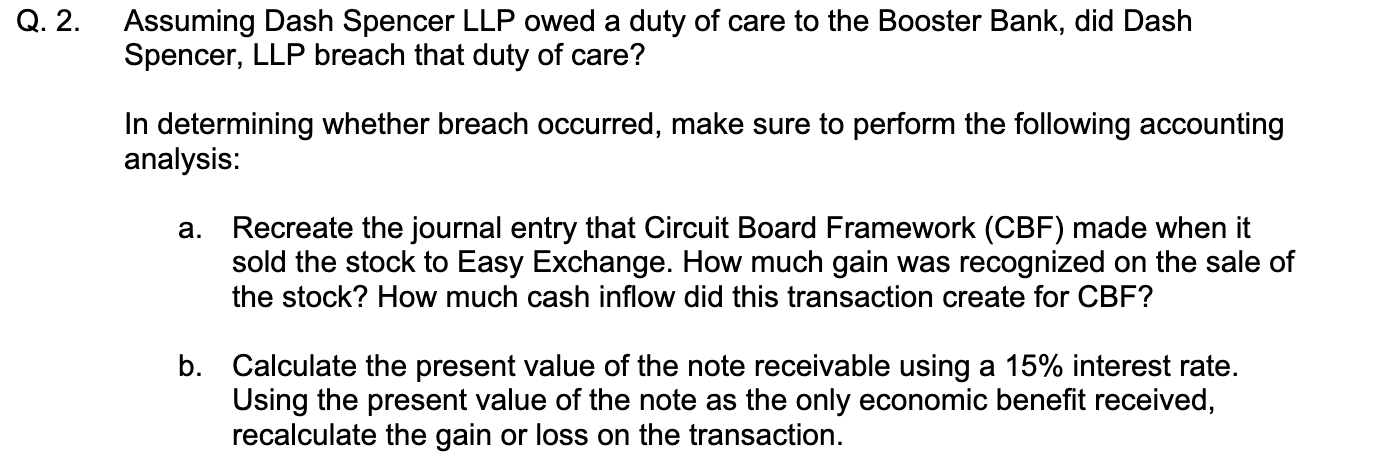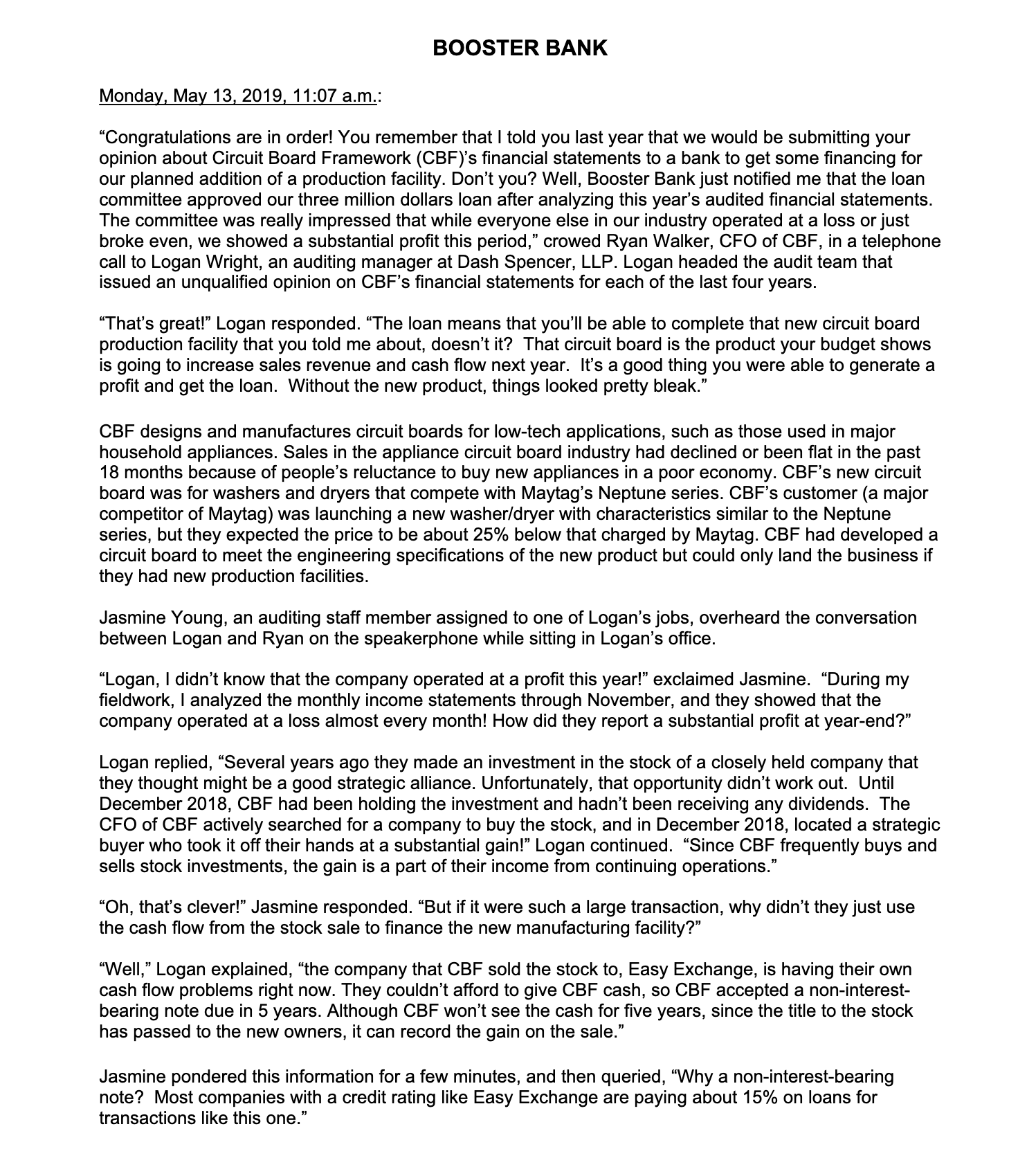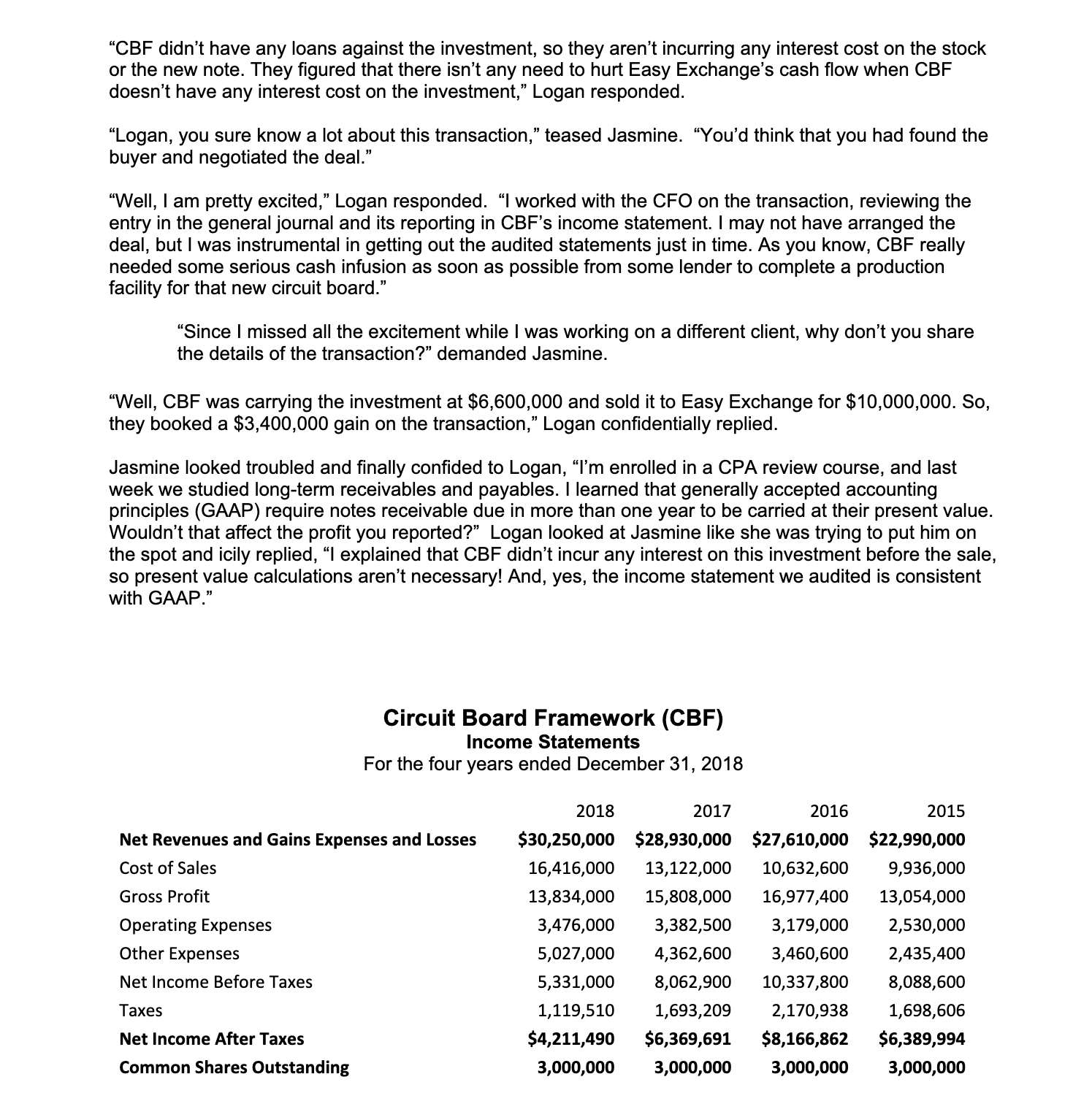Answered step by step
Verified Expert Solution
Question
1 Approved Answer
2. Assuming Dash Spencer LLP owed a duty of care to the Booster Bank, did Dash Spencer, LLP breach that duty of care? In determining


 2. Assuming Dash Spencer LLP owed a duty of care to the Booster Bank, did Dash Spencer, LLP breach that duty of care? In determining whether breach occurred, make sure to perform the following accounting analysis: a. Recreate the journal entry that Circuit Board Framework (CBF) made when it sold the stock to Easy Exchange. How much gain was recognized on the sale of the stock? How much cash inflow did this transaction create for CBF? b. Calculate the present value of the note receivable using a 15% interest rate. Using the present value of the note as the only economic benefit received, recalculate the gain or loss on the transaction. BOOSTER BANK Monday, May 13, 2019, 11:07 a.m.: "Congratulations are in order! You remember that I told you last year that we would be submitting your opinion about Circuit Board Framework (CBF)'s financial statements to a bank to get some financing for our planned addition of a production facility. Don't you? Well, Booster Bank just notified me that the loan committee approved our three million dollars loan after analyzing this year's audited financial statements. The committee was really impressed that while everyone else in our industry operated at a loss or just broke even, we showed a substantial profit this period," crowed Ryan Walker, CFO of CBF, in a telephone call to Logan Wright, an auditing manager at Dash Spencer, LLP. Logan headed the audit team that issued an unqualified opinion on CBF's financial statements for each of the last four years. "That's great!" Logan responded. "The loan means that you'll be able to complete that new circuit board production facility that you told me about, doesn't it? That circuit board is the product your budget shows is going to increase sales revenue and cash flow next year. It's a good thing you were able to generate a profit and get the loan. Without the new product, things looked pretty bleak." CBF designs and manufactures circuit boards for low-tech applications, such as those used in major household appliances. Sales in the appliance circuit board industry had declined or been flat in the past 18 months because of people's reluctance to buy new appliances in a poor economy. CBF's new circuit board was for washers and dryers that compete with Maytag's Neptune series. CBF's customer (a major competitor of Maytag) was launching a new washer/dryer with characteristics similar to the Neptune series, but they expected the price to be about 25% below that charged by Maytag. CBF had developed a circuit board to meet the engineering specifications of the new product but could only land the business if they had new production facilities. Jasmine Young, an auditing staff member assigned to one of Logan's jobs, overheard the conversation between Logan and Ryan on the speakerphone while sitting in Logan's office. "Logan, I didn't know that the company operated at a profit this year!" exclaimed Jasmine. "During my fieldwork, I analyzed the monthly income statements through November, and they showed that the company operated at a loss almost every month! How did they report a substantial profit at year-end?" Logan replied, "Several years ago they made an investment in the stock of a closely held company that they thought might be a good strategic alliance. Unfortunately, that opportunity didn't work out. Until December 2018, CBF had been holding the investment and hadn't been receiving any dividends. The CFO of CBF actively searched for a company to buy the stock, and in December 2018, located a strategic buyer who took it off their hands at a substantial gain!" Logan continued. "Since CBF frequently buys and sells stock investments, the gain is a part of their income from continuing operations." "Oh, that's clever!" Jasmine responded. "But if it were such a large transaction, why didn't they just use the cash flow from the stock sale to finance the new manufacturing facility?" "Well," Logan explained, "the company that CBF sold the stock to, Easy Exchange, is having their own cash flow problems right now. They couldn't afford to give CBF cash, so CBF accepted a non-interestbearing note due in 5 years. Although CBF won't see the cash for five years, since the title to the stock has passed to the new owners, it can record the gain on the sale." Jasmine pondered this information for a few minutes, and then queried, "Why a non-interest-bearing note? Most companies with a credit rating like Easy Exchange are paying about 15% on loans for transactions like this one." "CBF didn't have any loans against the investment, so they aren't incurring any interest cost on the stock or the new note. They figured that there isn't any need to hurt Easy Exchange's cash flow when CBF doesn't have any interest cost on the investment," Logan responded. "Logan, you sure know a lot about this transaction," teased Jasmine. "You'd think that you had found the buyer and negotiated the deal." "Well, I am pretty excited," Logan responded. "I worked with the CFO on the transaction, reviewing the entry in the general journal and its reporting in CBF's income statement. I may not have arranged the deal, but I was instrumental in getting out the audited statements just in time. As you know, CBF really needed some serious cash infusion as soon as possible from some lender to complete a production facility for that new circuit board." "Since I missed all the excitement while I was working on a different client, why don't you share the details of the transaction?" demanded Jasmine. "Well, CBF was carrying the investment at $6,600,000 and sold it to Easy Exchange for $10,000,000. So, they booked a $3,400,000 gain on the transaction," Logan confidentially replied. Jasmine looked troubled and finally confided to Logan, "I'm enrolled in a CPA review course, and last week we studied long-term receivables and payables. I learned that generally accepted accounting principles (GAAP) require notes receivable due in more than one year to be carried at their present value. Wouldn't that affect the profit you reported?" Logan looked at Jasmine like she was trying to put him on the spot and icily replied, "I explained that CBF didn't incur any interest on this investment before the sale, so present value calculations aren't necessary! And, yes, the income statement we audited is consistent with GAAP." Circuit Board Framework (CBF) Income Statements For the four years ended December 31, 2018
2. Assuming Dash Spencer LLP owed a duty of care to the Booster Bank, did Dash Spencer, LLP breach that duty of care? In determining whether breach occurred, make sure to perform the following accounting analysis: a. Recreate the journal entry that Circuit Board Framework (CBF) made when it sold the stock to Easy Exchange. How much gain was recognized on the sale of the stock? How much cash inflow did this transaction create for CBF? b. Calculate the present value of the note receivable using a 15% interest rate. Using the present value of the note as the only economic benefit received, recalculate the gain or loss on the transaction. BOOSTER BANK Monday, May 13, 2019, 11:07 a.m.: "Congratulations are in order! You remember that I told you last year that we would be submitting your opinion about Circuit Board Framework (CBF)'s financial statements to a bank to get some financing for our planned addition of a production facility. Don't you? Well, Booster Bank just notified me that the loan committee approved our three million dollars loan after analyzing this year's audited financial statements. The committee was really impressed that while everyone else in our industry operated at a loss or just broke even, we showed a substantial profit this period," crowed Ryan Walker, CFO of CBF, in a telephone call to Logan Wright, an auditing manager at Dash Spencer, LLP. Logan headed the audit team that issued an unqualified opinion on CBF's financial statements for each of the last four years. "That's great!" Logan responded. "The loan means that you'll be able to complete that new circuit board production facility that you told me about, doesn't it? That circuit board is the product your budget shows is going to increase sales revenue and cash flow next year. It's a good thing you were able to generate a profit and get the loan. Without the new product, things looked pretty bleak." CBF designs and manufactures circuit boards for low-tech applications, such as those used in major household appliances. Sales in the appliance circuit board industry had declined or been flat in the past 18 months because of people's reluctance to buy new appliances in a poor economy. CBF's new circuit board was for washers and dryers that compete with Maytag's Neptune series. CBF's customer (a major competitor of Maytag) was launching a new washer/dryer with characteristics similar to the Neptune series, but they expected the price to be about 25% below that charged by Maytag. CBF had developed a circuit board to meet the engineering specifications of the new product but could only land the business if they had new production facilities. Jasmine Young, an auditing staff member assigned to one of Logan's jobs, overheard the conversation between Logan and Ryan on the speakerphone while sitting in Logan's office. "Logan, I didn't know that the company operated at a profit this year!" exclaimed Jasmine. "During my fieldwork, I analyzed the monthly income statements through November, and they showed that the company operated at a loss almost every month! How did they report a substantial profit at year-end?" Logan replied, "Several years ago they made an investment in the stock of a closely held company that they thought might be a good strategic alliance. Unfortunately, that opportunity didn't work out. Until December 2018, CBF had been holding the investment and hadn't been receiving any dividends. The CFO of CBF actively searched for a company to buy the stock, and in December 2018, located a strategic buyer who took it off their hands at a substantial gain!" Logan continued. "Since CBF frequently buys and sells stock investments, the gain is a part of their income from continuing operations." "Oh, that's clever!" Jasmine responded. "But if it were such a large transaction, why didn't they just use the cash flow from the stock sale to finance the new manufacturing facility?" "Well," Logan explained, "the company that CBF sold the stock to, Easy Exchange, is having their own cash flow problems right now. They couldn't afford to give CBF cash, so CBF accepted a non-interestbearing note due in 5 years. Although CBF won't see the cash for five years, since the title to the stock has passed to the new owners, it can record the gain on the sale." Jasmine pondered this information for a few minutes, and then queried, "Why a non-interest-bearing note? Most companies with a credit rating like Easy Exchange are paying about 15% on loans for transactions like this one." "CBF didn't have any loans against the investment, so they aren't incurring any interest cost on the stock or the new note. They figured that there isn't any need to hurt Easy Exchange's cash flow when CBF doesn't have any interest cost on the investment," Logan responded. "Logan, you sure know a lot about this transaction," teased Jasmine. "You'd think that you had found the buyer and negotiated the deal." "Well, I am pretty excited," Logan responded. "I worked with the CFO on the transaction, reviewing the entry in the general journal and its reporting in CBF's income statement. I may not have arranged the deal, but I was instrumental in getting out the audited statements just in time. As you know, CBF really needed some serious cash infusion as soon as possible from some lender to complete a production facility for that new circuit board." "Since I missed all the excitement while I was working on a different client, why don't you share the details of the transaction?" demanded Jasmine. "Well, CBF was carrying the investment at $6,600,000 and sold it to Easy Exchange for $10,000,000. So, they booked a $3,400,000 gain on the transaction," Logan confidentially replied. Jasmine looked troubled and finally confided to Logan, "I'm enrolled in a CPA review course, and last week we studied long-term receivables and payables. I learned that generally accepted accounting principles (GAAP) require notes receivable due in more than one year to be carried at their present value. Wouldn't that affect the profit you reported?" Logan looked at Jasmine like she was trying to put him on the spot and icily replied, "I explained that CBF didn't incur any interest on this investment before the sale, so present value calculations aren't necessary! And, yes, the income statement we audited is consistent with GAAP." Circuit Board Framework (CBF) Income Statements For the four years ended December 31, 2018 Step by Step Solution
There are 3 Steps involved in it
Step: 1

Get Instant Access to Expert-Tailored Solutions
See step-by-step solutions with expert insights and AI powered tools for academic success
Step: 2

Step: 3

Ace Your Homework with AI
Get the answers you need in no time with our AI-driven, step-by-step assistance
Get Started


